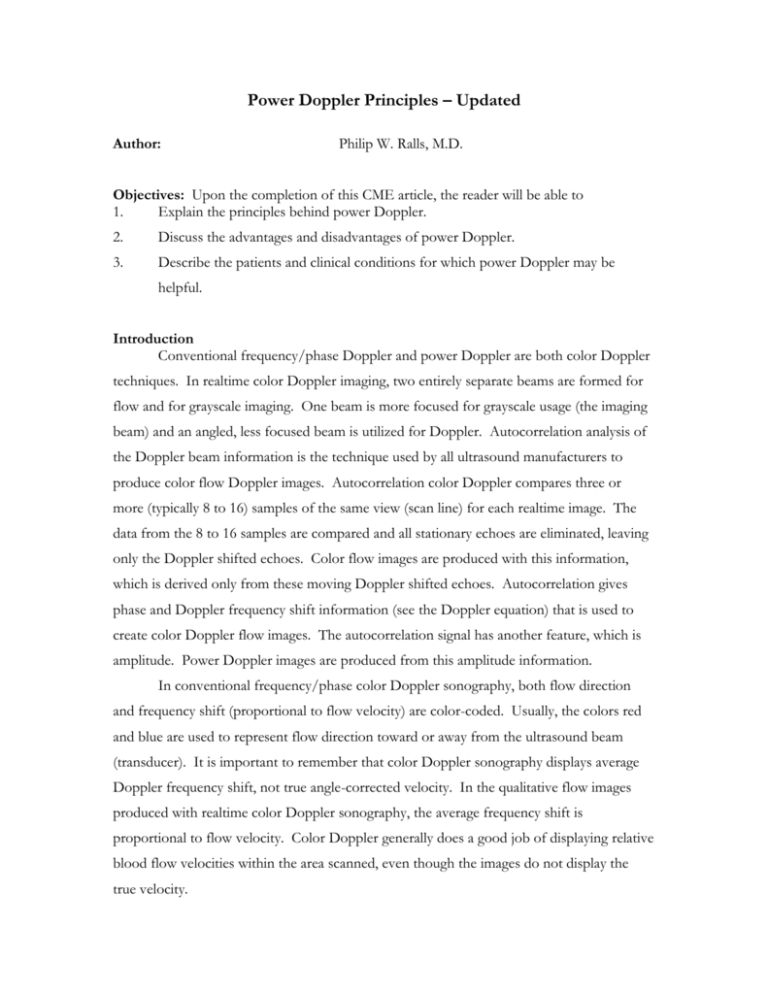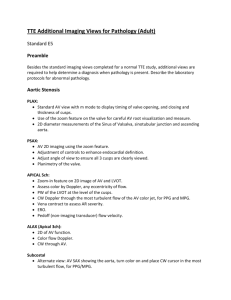to this article as a Word Document - e
advertisement

Power Doppler Principles – Updated Author: Philip W. Ralls, M.D. Objectives: Upon the completion of this CME article, the reader will be able to 1. Explain the principles behind power Doppler. 2. Discuss the advantages and disadvantages of power Doppler. 3. Describe the patients and clinical conditions for which power Doppler may be helpful. Introduction Conventional frequency/phase Doppler and power Doppler are both color Doppler techniques. In realtime color Doppler imaging, two entirely separate beams are formed for flow and for grayscale imaging. One beam is more focused for grayscale usage (the imaging beam) and an angled, less focused beam is utilized for Doppler. Autocorrelation analysis of the Doppler beam information is the technique used by all ultrasound manufacturers to produce color flow Doppler images. Autocorrelation color Doppler compares three or more (typically 8 to 16) samples of the same view (scan line) for each realtime image. The data from the 8 to 16 samples are compared and all stationary echoes are eliminated, leaving only the Doppler shifted echoes. Color flow images are produced with this information, which is derived only from these moving Doppler shifted echoes. Autocorrelation gives phase and Doppler frequency shift information (see the Doppler equation) that is used to create color Doppler flow images. The autocorrelation signal has another feature, which is amplitude. Power Doppler images are produced from this amplitude information. In conventional frequency/phase color Doppler sonography, both flow direction and frequency shift (proportional to flow velocity) are color-coded. Usually, the colors red and blue are used to represent flow direction toward or away from the ultrasound beam (transducer). It is important to remember that color Doppler sonography displays average Doppler frequency shift, not true angle-corrected velocity. In the qualitative flow images produced with realtime color Doppler sonography, the average frequency shift is proportional to flow velocity. Color Doppler generally does a good job of displaying relative blood flow velocities within the area scanned, even though the images do not display the true velocity. Factors Influencing the Flow Image In the context of color Doppler sonography, the Doppler effect refers to the frequency shift that is observed when sound is reflected from a moving target – i.e. red blood cell aggregates. Frequency (fd) = 2 f V cosine _______________________ C F (fd) = Doppler shift frequency (the difference between the transmitted and received frequencies) f = Frequency of the incident US beam (emitted from transducer) C = Speed of sound in the body (assumed to be 1540 m/s) V = RBC Velocity = Angle of US beam to Flow direction From the Doppler equation seen above, we see that the Doppler shift is influenced by the following factors: 1. the FREQUENCY of the ultrasound beam (f) used to interrogate flow 2. the ANGLE of the ultrasound beam to flow direction () 3. the VELOCITY of flowing red blood cell aggregates (V) For clinical Doppler sonography, the primary entities that scatter the ultrasound transmission (which are aggregates of RBCs) are much smaller than the wavelength of the ultrasound beam. Because of this size relationship, Rayleigh-Tyndall scattering governs the intensity of the backscattered echoes. This means that the signal intensity varies with the fourth power of the transmission beam frequency. Thus, if the Doppler frequency doubles (for example from 2 MHz to 4 MHz), signal intensity increases sixteen times. Conversely, lowering beam frequency (for example from 4 MHz to 2 MHz) results in one-sixteenth the signal. Obviously, higher frequency transducers (5 to 10 MHz) are more sensitive in scanning superficial flow because more signal results. Another advantage of high frequency transmission is better spatial resolution. The main disadvantage of high frequency transducers is poor tissue penetration. High frequency beams are quickly attenuated or lost. Frequency effects are much more important for Doppler sonography than for grayscale imaging. The Doppler frequency shift signal is many times fainter than the echoes used to produce grayscale images. As a practical matter, high frequency Doppler (5 to 7 MHz) simply can’t penetrate tissue well enough to obtain good flow information deeper than 6 cm in most patients. At depths beyond 6 cm, a lower frequency (2 to 3 MHz) is preferred for its better tissue penetration. However, there is a tradeoff between tissue penetration (low frequency) and higher Doppler shifts (high frequency). When superficial organs or vessels are scanned, tissue penetration is not a problem. It is better to use high frequency transducers because they yield greater frequency shifts. In abdominal and other deep Doppler applications, however, the need for adequate tissue penetration predominates. Obviously, if sound does not penetrate deep enough, flow cannot be displayed. Thus, in some cases, lower frequency transducers should be used even at the cost of lower echo intensity. In some patients, trying both higher and lower frequency may be needed to optimize flow imaging. With some modern high bandwidth transducers, several different Doppler frequencies can be produced, allowing more flexibility without having to change transducers. Lower scan angles produce larger Doppler shifts. Maximum Doppler frequency shift occurs when blood is flowing directly towards or away from the ultrasound beam (theta equals 0 or 180 degrees). Thus, scanning as close as is possible to 0 degrees will optimize sensitivity and minimize ambiguity in flow direction. Conversely, as the scan angle approaches 90 degrees, frequency shift decreases and the sensitivity decreases, increasing ambiguity. Hence, blood flowing perpendicular to the ultrasound beam (which is parallel to the transducer face) will not be displayed, because no Doppler shift is generated. Because flow is not truly uniform in any vessel, some color-coded flow may be seen, even in vessels that are apparently perpendicular to the beam. Another reason that some flow may be shown relates to the large opening of modern transducers. Blood flowing at uniform speed in a vessel is displayed as different colors when imaged at different angles. Thus, blood flow in a tortuous vessel will be represented by several different colors in the same image, with a black line representing the area where the flow direction changes. The black line occurs because the high pass filter (or “wall filter”) eliminates the very low frequency shifts that occur at a 90-degree scan angle. Sector and curved linear transducers produce divergent scan lines – their displays are wider in the far field than in the near field. Blood flow in a vessel parallel to the transducer face of a sector or curved linear transducer will be displayed as red on one side of the vessel and blue on the other, separated by an intervening black line. These color changes occur because the divergent scan lines intersect flow at different angles from one side of the image to the other. The velocity of blood flow is the most important parameter influencing the Doppler frequency shift. The purpose of color Doppler sonography is to display blood flow. Because color Doppler sonography images are not angle corrected, they actually display frequency shifts, not flow velocity. This ordinarily causes no clinical difficulty. Color Doppler images generally do a good job of displaying relative blood flow velocities within the area imaged. Beam characteristics have an important impact on Doppler ultrasound. A wide, relatively unfocused beam profile with a long pulse length is best for Doppler. An unfocused beam allows uniform power input into the target area (usually a vessel), and thus produces a more uniform frequency response. A Narrow focused beam, typically used for grayscale imaging, may result in random variability of the Doppler shift. With a tightly focused, narrow beam, the Doppler shift may be more related to suboptimal beam characteristics, rather than the actual flow velocity. Optimal Doppler sonography and grayscale imaging have conflicting requirements. Grayscale imaging is best performed with a 90-degree scan angle, a narrow focused beam, and short ultrasound pulses. On the other hand, Doppler scanning is maximal at 0 degrees using a relatively unfocused beam with a long pulse length. Frequency requirements also differ. Higher frequency is generally better for grayscale, where spatial resolution needs are important. With Doppler, penetration is very crucial and lower frequencies may achieve better results. These conflicting requirements make it easy to appreciate the engineering challenges involved in producing an effective realtime color Doppler sonographic system. Several approaches to this problem have been used in commercial instruments. Successful clinical color Doppler systems require advanced technology. Necessary features include (1) flexible and fast beam forming capabilities, (2) powerful computer processing, and (3) superb signal detection and processing. Because of these requirements, most color Doppler sonography is performed with either phased array or linear array transducers, because these have a sufficiently large number of elements and channels to allow appropriate beam formation. Power Doppler Techniques Autocorrelation yields both phase and frequency information (which is used to create color Doppler flow images) and amplitude. Amplitude can also be used to create flow images; however, these have picture characteristics that are different from traditional phase/frequency (color Doppler) images. Amplitude is integrated to reflect the power/energy of the autocorrelation signal. Various names have been given to this type of color flow imaging such as: power Doppler, color amplitude imaging, color power or color energy Doppler. We will use power Doppler, because that is the term used by Professor Jonathan Rubin (University of Michigan), who popularized this technique. The most important benefit of power Doppler imaging is improved flow sensitivity. With power Doppler, noise is much less disturbing than on conventional phase/frequency color Doppler images. Large noise-related frequency shifts can result in deceptive color artifacts that overwrite flow, seriously degrading the conventional color Doppler flow image. Put another way, power Doppler noise is always low amplitude – the flow in power Doppler “pops” easily out of the noise to become visible on the image. Because power Doppler has a better signal-to-noise ratio, this translates into better flow sensitivity. As a practical matter, power Doppler images can be amplified 10 to 15 dB more than phase/frequency color Doppler images before noise becomes intrusive. Consequently, with power Doppler flow imaging, one can scan at higher gain settings without destroying the image with artifact, achieving a 3 to 5 times better sensitivity than conventional phase/frequency color Doppler (figure1). Other characteristics of current power Doppler flow scanning include the absence of directional and velocity information and the ability to image flow better than color Doppler at scan angles closer to 90 degrees or perpendicular to the flow (figure 2). Two disadvantages of power Doppler are that it provides no information regarding flow velocity or flow direction. While flow detection is clearly the most important clinical use of color flow imaging, velocity and directional information are often diagnostically important. Therefore, conventional color Doppler is preferable to power Doppler, when maximum sensitivity is not required. Power Doppler is most useful in situations where optimal sensitivity is required, or when a more robust flow image is desired. For example, when a scan angle near 90 degrees is needed, power Doppler is preferred. Another major limitation of power Doppler is its greater susceptibility to “flash” artifacts related to tissue motion. “Flash” artifacts, caused by moving soft tissue, are very pronounced, because moving soft tissue has a much higher amplitude than flowing blood. Newer soft-tissue motion suppression techniques have mitigated this problem. In state-ofthe-art power Doppler systems, flash artifact suppression and the ability to track flow within moving soft-tissue is quite good. Modern instruments have actually lessened the sensitivity advantage of power Doppler over conventional color Doppler. Nevertheless, when optimal sensitivity is required, power Doppler is used. There has been some confusion associated with the detection of color artifacts in power Doppler images. When artifacts related to motion occur in power Doppler images, they are displayed superimposed on higher amplitude grayscale structures. This is the opposite of motion related flow artifacts in frequency/phase color Doppler flow images, where the color artifacts are displayed over low echogenicity or anechoic areas. The enhanced sensitivity from power Doppler flow imaging is useful in many scanning circumstances. One hope is that these techniques will eventually provide a parenchymal flow image in many organs. Such images are routinely possible with current technology in the high flow kidney (figure 3). Improved sensitivity and the addition of contrast agents may allow parenchymal contrast enhancement in the liver, spleen, and other organs. Figures 1 Improved sensitivity with Power Doppler 2 Power Doppler shows flow at 90 degrees, better than conventional color Doppler. 3 Renal perfusion image excludes renal cell carcinoma. References or Suggested Reading: 1. Kettenbach J, Helbich TH, Huber S, et al. Computer-assisted quantitative assessment of power Doppler US: effects of microbubble contrast agent in the differentiation of breast tumors. Eur J Radiol. 2005;53:238-44. 2. Scialpi M, Midiri M, Bartilotta TV, et al. Pancreatic carcinoma versus focal pancreatitis: contrast-enhanced power Doppler ultrasonography findings. Abdom Imaging. 2005;30:222-227. 3. Schroeder RJ, Bostanjoglo M, Rademaker J, et al. Role of power Doppler techniques and ultrasound contrast enhancement in the differential diagnosis of focal breast lesions. Eur Radiol. 2003;13:68-79. 4. Burns PN. The physical principles of Doppler and spectral analysis. J Clin Ultrasound 1987;15:567-590. 5. Forsberg F, Liu JB, Burns PN, et al. Artifacts in ultrasonic contrast agent studies. J Ultrasound Med 1994;13:357-365. 6. Kremkau, FW. Doppler Color Imaging: Principles and Instrumentation. Clinics of Diagnostic Ultrasound 1992;27:7-60. 7. Merritt CRB. Doppler color flow imaging. J Clin Ultrasound 1987;15:591-597. 8. Middleton WD, Erickson SJ, Melson GL. Perivascular color artifact: pathologic significance and appearance on color Doppler ultrasound imaging. Radiology 1989;171:647-65. 9. Middleton WD, Melson GL. The carotid ghost: a color Doppler ultrasound duplication artifact. JUM 1990;9:487-491. 10. Mitchell DG. Color Doppler Imaging: Principles, Limitations, and Artifacts. Radiology 1990;177:1-10 11 Nelson TR, Pretorius DH. The Doppler signal: where does it come from and what does it mean? AJR 1988;151:439-447. 12. Pellerito, JS, Troiano RN, Quedens-Case, C, et al. Common pitfalls of endovaginal color Doppler flow imaging. RadioGraphics 1995;15:37-47. 13. Pozniak MA, Zagzebski JA, Scanlan KA. Spectral and color Doppler artifacts. RadioGraphics 1992;12:35-44. 14. Rubin JM, Bude RO, Carson PL, et al. Power Doppler US: a potentially useful alternative to mean frequency based color Doppler US. Radiology 1994;190:853 15. Rubin JM. AAPM tutorial: spectral Doppler. Radiographics. 1994;14:139. About the Author Dr. Philip W. Ralls is a Professor of Radiology at Keck School of Medicine, University of Southern California. He is an active Radiologist and is a Fellow of the American College of Radiology and numerous other professional organizations. Dr. Ralls has presented numerous lectures on ultrasound topics at many different conferences around the country and is actively involved in research. In addition, he has authored several publications in peer-review medical journals. Examination: 1. Autocorrelation color Doppler typically compares _____ samples of the same view or scan line for each realtime image. A. 4 to 8 B. 8 to 16 C. 16 to 20 D. 20 to 24 E. 24 to 32 2. In conventional frequency/phase color Doppler sonography, usually, the colors ________ are used to represent flow direction toward or away from the ultrasound beam or transducer. A. blue and yellow B. blue and green C. red and yellow D. red and green E. red and blue 3. It is important to remember that color Doppler sonography displays A. true angle-corrected velocity. B. peak Doppler frequency shift. C. average Doppler frequency shift. D. true perpendicular velocity. E. trough Doppler frequency shift. 4. Based on the Doppler equation discussed in the article, the speed of sound in the body is assumed to be A. 540 m/s B. 715 m/s C. 1040 m/s D. 1540 m/s E. 1745 m/s 5. From the Doppler equation, Doppler shift is influenced by which of the following factors? A. assumed speed of sound in the body B. angle of the ultrasound beam to flow velocity C. depth of the tissue that is penetrated D. frequency of the ultrasound beam that is used E. amount of Rayleigh-Tyndall scattering 6. For clinical Doppler sonography, the primary entities that scatter the ultrasound transmission are A. fatty tissues in the subcutaneous layer B. aggregates of RBCs C. fibrous tissues in the subcutaneous layer D. aggregates of platelets E. calcified tissues 7. For clinical Doppler sonography, Rayleigh-Tyndall scattering governs the intensity of the backscattered echoes, which means that the signal intensity varies with the _________ power of the transmission beam frequency. A. second B. third C. fourth D. fifth E. sixth 8. Regarding tissue penetration, at depths beyond 6 cm, a frequency of ______ MHz is usually preferred because of its better tissue penetration. A. 2 to 3 B. 3 to 5 C. 5 to 7 D. 7 to 10 E. 10 to 12 9. Regarding scan angles, blood flowing _________ the ultrasound beam will not be displayed, because no Doppler shift is generated. A. directly toward B. in the opposite direction from C. at a 30 degree angle away from D. at a 60 degree angle away from E. perpendicular to 10. Blood flow in a tortuous vessel will be represented by several different colors in the same image, with a black line representing the area where the flow direction changes. The black line occurs because the A. high pass filter eliminates the very low frequency shifts that occur at a 90 degree scan angle. B. flow is not consistent. C. transducer filter exaggerates the high frequency shifts that occur at 0 and 180 degree scan angles. D. computer logic of the ultrasound machine interprets the combination of blue and red in that area as black. E. machine is programmed to use that color when the direction changes. 11. Beam characteristics have an important impact on Doppler ultrasound. What is best for Doppler is a A. narrow but relatively unfocused beam profile with a short pulse length. B. narrow focused beam profile with a long pulse length. C. wide but focused beam profile – the pulse length is of no concern. D. wide but focused beam profile with a short pulse length. E. wide, relatively unfocused beam profile with a long pulse length. 12. Optimal Doppler sonography and grayscale imaging have conflicting requirements. Grayscale imaging is best performed with a A. B. C. D. E. 0-degree scan angle, a narrow focused beam, and long ultrasound pulses. 0-degree scan angle, a wide beam, and short ultrasound pulses. 45-degree scan angle, a wide beam, and short ultrasound pulses. 90-degree scan angle, a narrow focused beam, and short ultrasound pulses. 90-degree scan angle, a wide beam, and long ultrasound pulses. 13. Successful clinical color Doppler systems require advanced technology. Necessary features include A. powerful computer processing B. rigid beam forming capabilities C. superb signal creation and processing D. slow beam forming capabilities E. low frequency sector transducers 14. The term __________ was used by Professor Jonathan Rubin (University of Michigan), who popularized this technique. A. color energy Doppler. B. energy Doppler C. color amplitude imaging D. color power E. power Doppler 15. The most important benefit of power Doppler imaging is improved A. direction detection B. velocity detection C. flow sensitivity D. vessel identification E. vessel wall compliance 16. As a practical matter, power Doppler images can be amplified ______ dB more than phase/frequency color Doppler images before noise becomes intrusive. A. 5 to 10 B. 10 to 15 C. 15 to 20 D. 20 to 25 E. 25 to 30 17. The disadvantages of power Doppler are that it provides no information regarding A. flow velocity B. vessel wall compliance C. quantity of RBC aggregates D. flow detection E. blood vessel location 18. Power Doppler is most useful in situations where optimal sensitivity is required for the A. detection of vessel wall location. B. velocity of flow. C. D. E. detection of flow. detection of vessel wall compliance. direction of flow. 19. Another major limitation of power Doppler is its greater susceptibility to “flash” artifacts related to A. the direction of blood flow movement B. tissue motion C. RBC aggregate movement D. blood pressure changes E. changes in the heart rate 20. When artifacts related to motion occur in power Doppler images, they are displayed A. within the anechoic areas. B. within the low echogenicity areas. C. superimposed on lower amplitude color Doppler images. D. superimposed on higher amplitude grayscale structures. E. superimposed on the side beam artifacts of color Doppler images.






